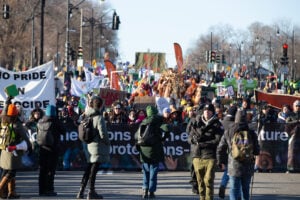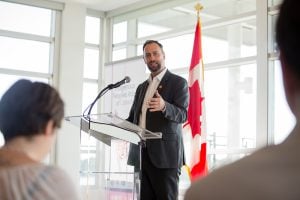
Environment
Inside the fight to protect the Arctic’s “Water Heart”
How the Sahtuto’ine Dene of Déline created the Tsá Tué Biosphere Reserve, the world’s first such UNESCO site managed by an Indigenous community
- 1693 words
- 7 minutes
This article is over 5 years old and may contain outdated information.
People & Culture

Sometimes, writing a magazine feature story is much more than just writing a magazine feature story. Sometimes, the people you are interviewing puncture you and you can’t leave them behind.
So it was with the interviews I did last month with the six members of the Survivors’ Circle of the National Centre for Truth and Reconciliation, plus Eugene Arcand of the Centre’s Governing Circle. Each was taken as a child and forced to live in a residential school.
Barney Williams, of the Tla-o-qui-aht First Nation in B.C., lives on in my heart. So dignified and kind, his voice broke as he talked about how the residential school starved him and the other children. About how even now at suppertime, he has to convince himself not to be afraid that he will be hungry through the night.
We talked for an hour. He told me he would be calling a friend after we got off the phone, a way to deal with the trauma of having told his story once more. “It’s something I do to make sure I’m okay,” he said.
The day I spoke with Eugene Arcand, Cree of the Muskeg Lake First Nation in Saskatchewan, he couldn’t bear to tell me what he went through in residential school. His voice ached with exhaustion. He was driving on the highway north of Regina – a road from my own childhood – and he was emotionally drained from having just spoken to a group about the experience. “It’s not something we can turn on and off because someone requests an interview,” he said.
Kukdookaa Terri Brown, of the Crow clan, Tahltan Nation, in B.C., sobbed uncontrollably (and I did too) as she talked about her beloved brother, Harry, who froze to death at 33. She was driving to an elders’ gathering in Edmonton and had pulled off to the side of the highway so we could chat. “He never recovered [from being in a residential school]. I don’t know what happened to him. I can only imagine.”
But along with the tragedies, she also wanted me to know about the triumphs of the new generation. Her little granddaughter attends a school run by the First Nation on their own land. When she has a problem – like the tearful day she forgot her snack – Mom and Dad are right down the street to deal with it.
Such was the grace of Ted Quewezance of Keeseekoose First Nation in Saskatchewan, that after he finished telling me about the brutality of life in a residential school – they scrubbed small children until they bled, shaved their heads, beat them and sexually abused them – he took pains to assure me that he was okay. “I’m in a safe place,” he said, softly.
Doris Young of the Opaskwayak Cree Nation in Manitoba questioned me like a defense attorney, and then set forth a challenge. Was I a First Nations person? No. Had I talked with other First Nations people about their lives? Yes. Were any Indigenous people my friends? Yes. Well, then, what was I going to do in the name of reconciliation?
“When you take on this kind of information and distribute it, you have to throw in what you are willing to do because you know this information now. You can’t say: ‘I don’t know about it,’” she told me.
To my shame, I didn’t give you a good answer, Ms. Young. All I said was that I was in deep mourning for the country we could have been had genocide and racism not reigned. I know it’s only a starting place.
I wish I had told you that I am determined to keep talking and writing about the horrors of the past. I think too few people know about the history of racism and genocide that tears at the heart of our country. I wish I had told you how much I long for the time when every Canadian can help weave the tapestry of our country’s future.
So what can I offer? More proof that the silence of the stolen children has been irrevocably broken. You have voices and they are cherished. Abusers always forget that children – when they survive – grow up and testify and are believed.
And that, hard as it was for all of you to tell the stories and for me to hear them, your stories matter. Greatly. To me and to many others. The stories live.
Are you passionate about Canadian geography?
You can support Canadian Geographic in 3 ways:

Environment
How the Sahtuto’ine Dene of Déline created the Tsá Tué Biosphere Reserve, the world’s first such UNESCO site managed by an Indigenous community

People & Culture
Indigenous knowledge allowed ecosystems to thrive for millennia — and now it’s finally being recognized as integral in solving the world’s biodiversity crisis. What part did it play in COP15?

People & Culture
The director of the National Centre for Truth and Reconciliation reflects on Indigenous progress in 2017 and looks ahead to 2067

History
A look back at the early years of the 350-year-old institution that once claimed a vast portion of the globe